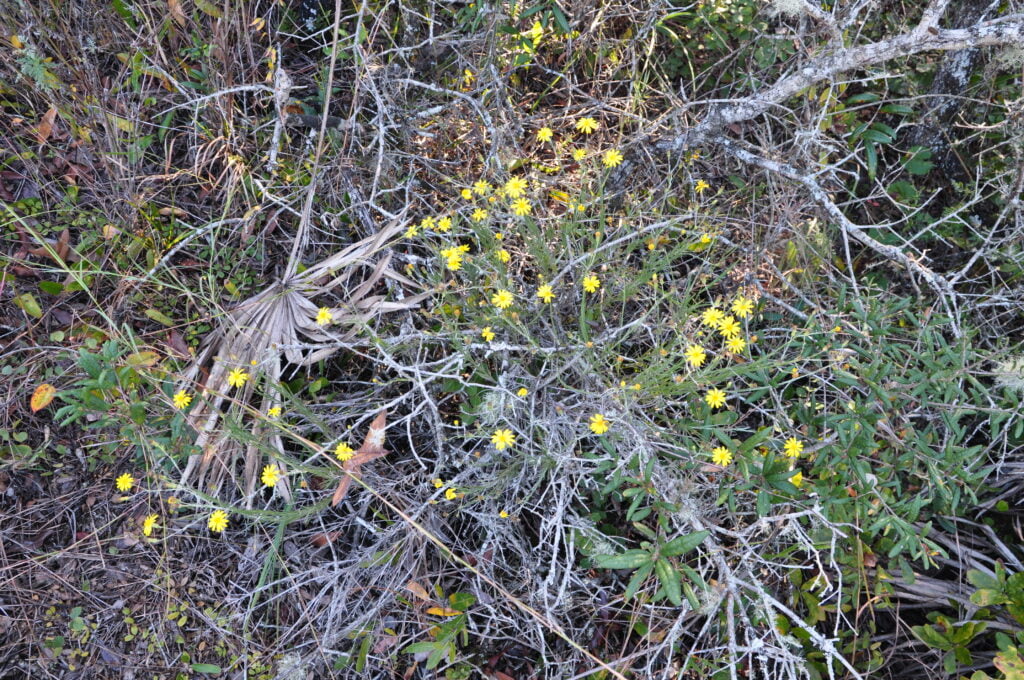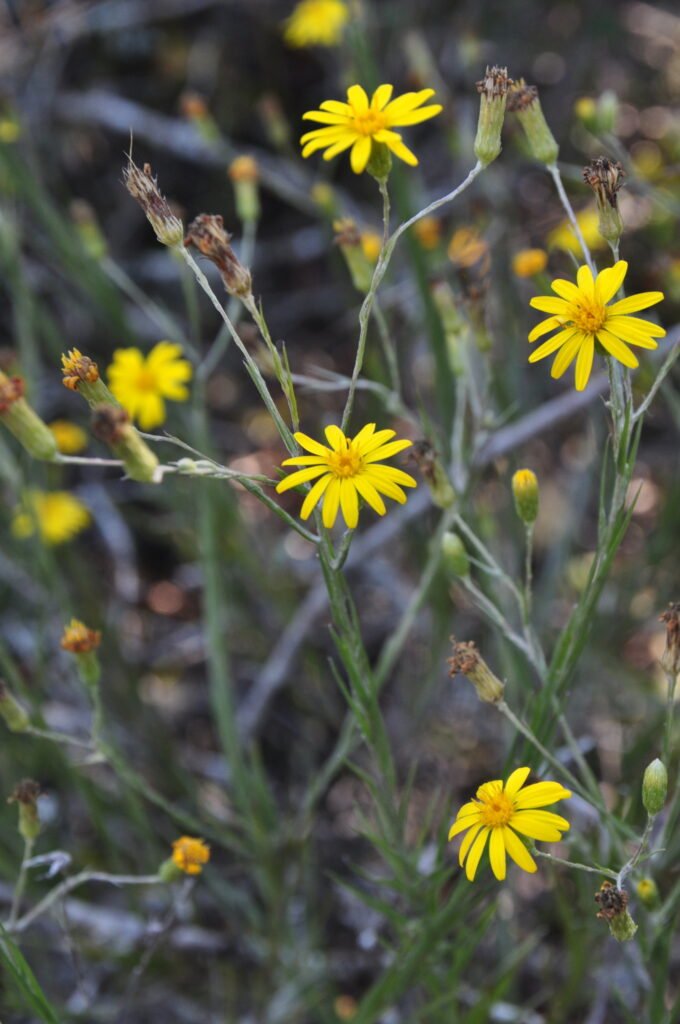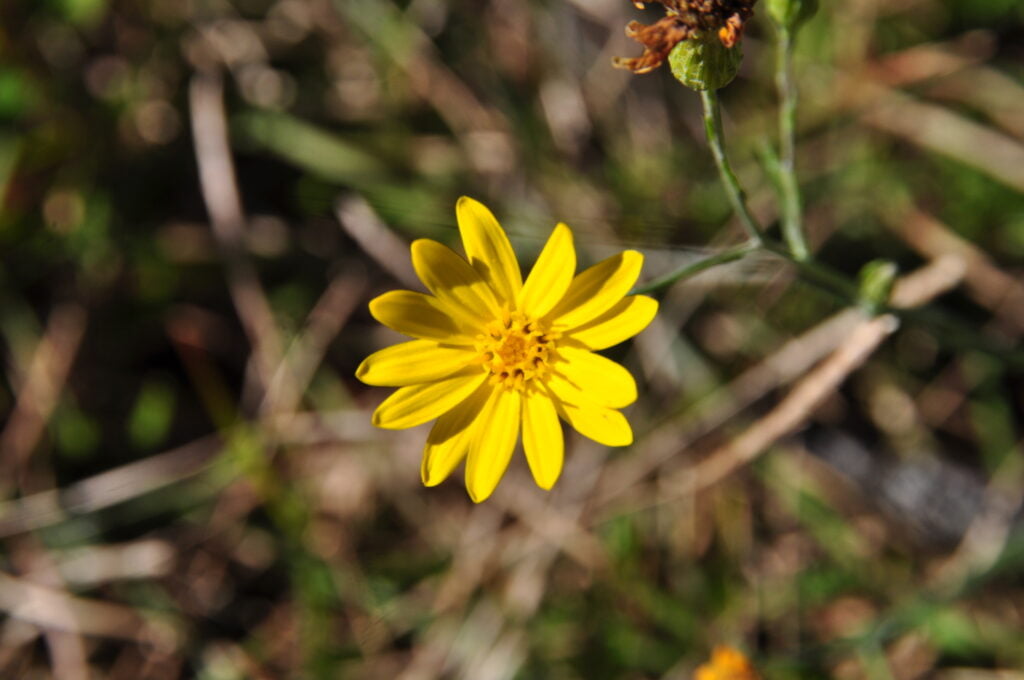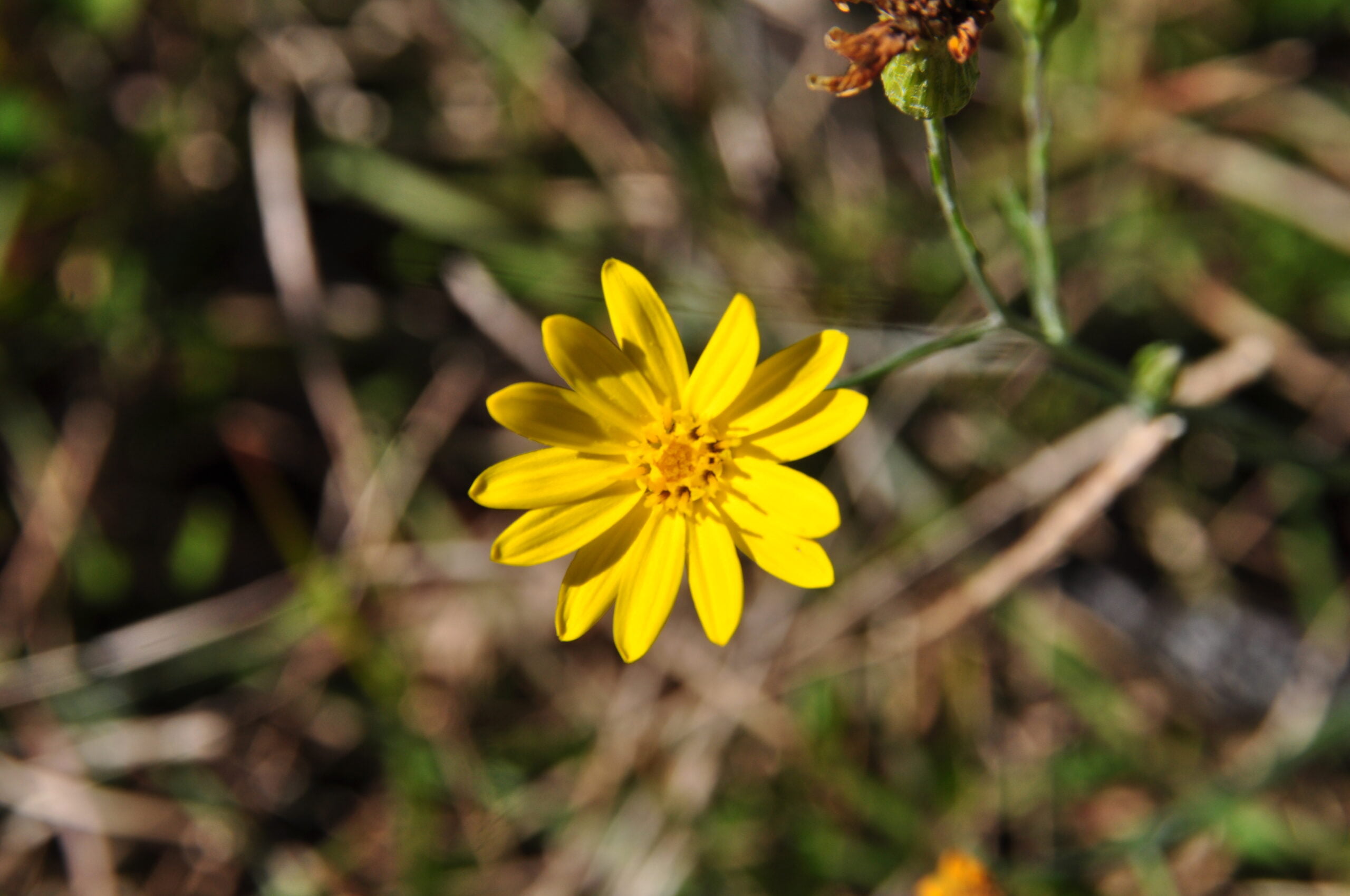Pityopsis is a genus of grass-leaved goldenasters which has suffered many taxonomic challenges. Central Florida is the center of diversity for the genus, which only adds to the difficulties in identification.
These challenges are a result of a lack of recognition of fire-adaptations, along with hybridization between species across the range of the Lake Wales Ridge.
This, combined with a tendency to lump all species into Pityopsis graminifolia Michx. Nutt., has led to the problems in the proper identification of Pityopsis in Central Florida.

The most recent taxonomic changes for Pityopsis has proposed three species that are endemic to peninsular Florida: Pityopsis aequilifolia, P. microcephala, and P. tracii. These plus P. graminifolia and P. latifolia make up the five species found in Florida.
P. graminifolia was only found once in Lake county, otherwise it is found in the northwest of the state. P. latifolia is endemic to South Florida, and will not be found in Central Florida.
That means only three Pityopsis species will be observed on the Lake Wales Ridge: P. aequifolia, P. microcephela, and P. tracii.
Identifying Pityopsis
While never perfect and complete, an identification key has been provided which should produce the correct species per the latest taxonomic revision. It will require a ruler for measurement of the various anatomical parts which make up most of the characteristics of the species.
1. Basal Leaves
The first and most important identifying characteristic of Silkgrass is the basal leaves, or those leaves closes to the roots. Therefore, step one is to make note of basal leaf size and shape.
Essentially, if the basal leaves are similar in size and shape to the stem leaves, you have either P. aequifolia or P. latifolia. Since P. latifolia is endemic to South Florida, you will probably have P. aequifolia.
Alternately, if the basal leaves are much longer than the stem leaves, and the middle leaves are larger than the stem leaves, you have either P. tracyi, P. graminifolia, or P. microcephela. Again, P. graminifolia is not normally found in Central Florida, so it can usually be ruled out.
Measuring with a ruler is best, however digital images can still be used to identify. The basal leaves and the stem leaves must be in focus, and show relative scale. It must be clear that the basal leaves are the same size, or larger than the stem or even middle leaves.
Without the relative basal leaf size, genus Pityopsis is the closest a digital photo will be able to achieve.
2. Involcures
Involcures are not quite leaves, and not quite flowers. Simply put, involcures are rings of bracts. Bracts are modified or specialized leaves, usually associated with flowers. Goldenasters have rings of bracts between the florets and the stem. These are the second most important identifying characteristic of Pityopsis.

The length of the involcures is the critical element. The involcures will either be short (5-8mm), medium (8-12mm) or long (12-14mm).
Basal leaves and involcures are still not enough to accurately identify any given Silkgrass in Florida. For example, P. aequifolia has involcure length between 5 and 8mm whereas P. latifolia have involcures between 8 and 12mm. That means either P. latifolia or P. aequifolia can have involcure lengths of 8mm.
3. Florets
The next most important identifying characteristic of Pityopsis are florets. Goldenasters are technically not a flower, but clusters of many smaller flowers, called florets.
Goldenasters have two kinds of florets. Disc florets and ray florets. The disc floret is the center of the flower, and the ray floret make up the parts that look like petals around the center.

Therefore, the number of flowers that make up the disc and ray florets is the third most important characteristic.
Even still, basal leaf size and shape, involcure size, and floret count is still not enough to identify each species of Pityopsis in Florida. There is still one remaining characteristic.
4. Phyllaries
Phyllaries are leaflets which make up involcures. These leaflets can either have hairy glands not. This will help determine between P. graminifolia and P. microcephela.
P. graminifolia will have fine hairs tipped with glands on their phylarries. P. microcephela will have none, or very few.
Of the two, Central Florida and the Lake Wales Ridge will have P. microcephela, which are without glands.
Identification Key
KEY TO PITYOPSIS IN CENTRAL AND SOUTHERN PENINSULAR FLORIDA
| 1 . Basal leaves similar in size and shape to stem leaves, the stem leaves not noticeably reduced upward; middle and up- per stem leaves ascending to somewhat spreading, | |
| 2. Involucres 5-8 mm high; disc florets 15-29; stem leaves dense, stiff and sharply pointed | P. aequifolia |
| 2. Involucres 8-12 mm high; disc florets > 30; stem leaves few, soft and obtuse or slightly acute | P. latifolia |
| 1 . Basal leaves much longer than the stem leaves; stem leaves strongly reduced upward, the upper stem leaves much smaller than middle stem leaves, appressed to the stem or near | |
| 3. Involucres 12-14 mm high; disc florets > 30; ray florets 13-25; flowering plants robust, often 50-100 cm tall; largest basal leaves on sterile shoots 15-30 cm long, 5-10 mm wide | P. tracyi |
| 3. Involucres 5-8 mm high; disc florets 15-29; ray florets 5-12; flowering plants more delicate, usually less than 50 cm tall; largest basal leaves on sterile shoots 10-25 cm long, 1-3 mm wide; largest stem leaves 2-6 cm long, 1-3 mm | |
| 4. Inner phyllaries densely stipitate-glandular, at least distally | P. graminifolia |
| 4. Inner phyllaries eglandular to sparsely glandular | P. microcephala |
Glossary
acute: leaf ending in a sharp point
appressed: pressed close to or lying flat against
basal: being close to the root
bract: modified or specialized leaf, usually associated with/below flowers
disc floret: cluster of flowers in the center of a goldenaster, surrounded by ray florets
distally: farthest from a point of reference
eglandular: having no glands
floret: flower cluster made up of many smaller flowers
goldenaster: common name for certain yellow flowers in the aster family
involucre: one or more whorls of bracts situated below and close to a flower
obtuse: leaf rounded at the free end
phyllaris: one of the leaflets forming the involucre of composite flowers
ray floret: clusters of flowers making up the “petals” around the disc floret
sterile: part enveloping the flower (perianth) which is neither male nor female
stipitate: having a stalk (stipe)
stipitate-glandular: hairlike stalk with a gland at the end
whorl: a ring of similar anatomical parts in a circle around a point on an axis
References
Weakley, A. S., Poindexter, D. B., LeBlond, R. J., Sorrie, B. A., Bridges, E. L., Orzell, S. L., Franck, A. R., Schori, M., Keener, B. R., Diamond, A. R., Floden, A. J., & Noyes, R. D. (2018). NEW COMBINATIONS, RANK CHANGES, AND NOMENCLATURAL AND TAXONOMIC COMMENTS IN THE VASCULAR FLORA OF THE SOUTHEASTERN UNITED STATES. III. Journal of the Botanical Research Institute of Texas, 12(1), 27–67. http://www.jstor.org/stable/44858905

